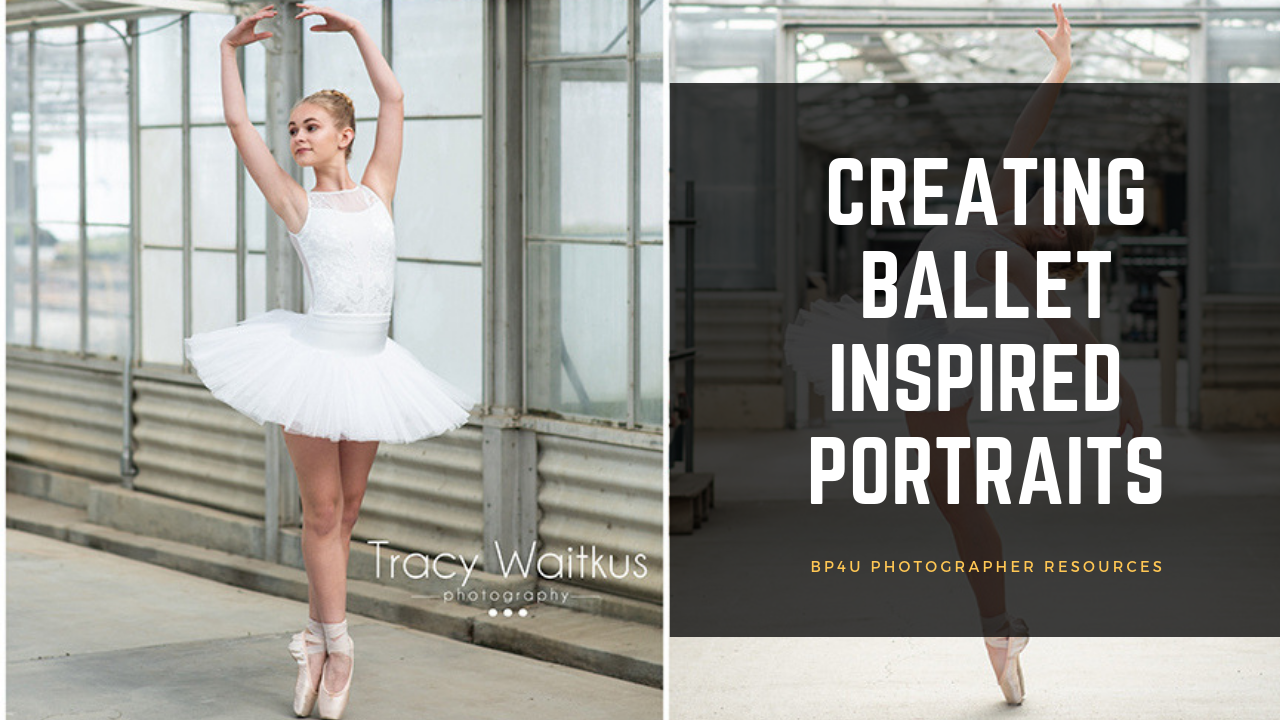Shooting dancers in beautiful or interesting outdoor locations is one of my favorite types of photography. Dancers spend hours in the studio perfecting their lines and technique and their stunning combination of grace and athleticism is such fun to capture. Here are a few tips for working with dancers at outdoor locations.
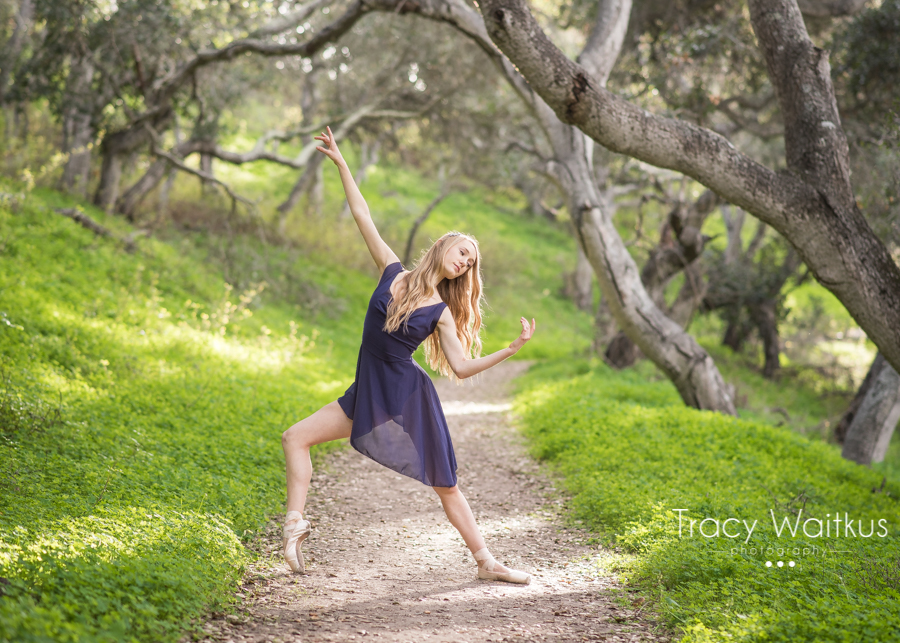
@kassandra.rose.dance photographed in a grove of oak trees with a Nikon D750 and Nikon 85mm 1.8 lens.
Choosing a Location
Whether I’m shooting for an individual client, a dance studio or company, or doing a creative shoot of my own, I usually begin my session planning by selecting the location. Some of my considerations include: Does the location provide multiple backdrops so we can create a variety of images? Does the location offer enough space for the dancer(s) to pose and/or leap without constraint? Does the location provide a safe, stable surface for a dancer wearing pointe shoes? For beach locations, will the tides be favorable on the day/time of the shoot? Will the location be crowded on the day of the shoot, and will having lots of passersby be intimidating for the dancer(s)? Will there be access to a restroom or private area for changing costumes during the shoot?
Very fortunately for me, I live in an area with an array of wonderful locations that are open to the public, and here in California, we can shoot outdoors year-round. The images below were captured during the same shoot at a location in Pismo Beach.
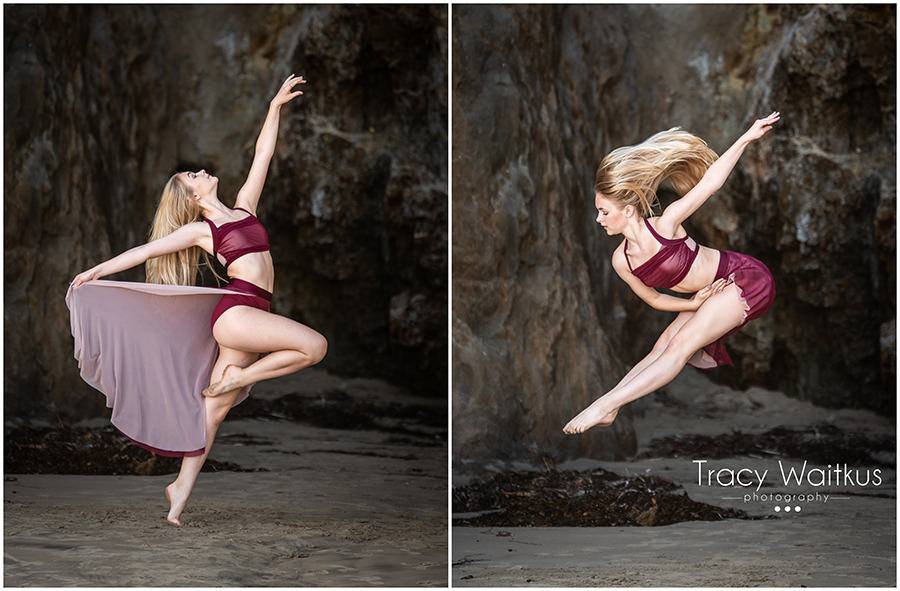
@gracephillips.dance captured in a cave at Pismo Beach, California with a Nikon D750 and Sigma 70-200mm 2.8 lens.
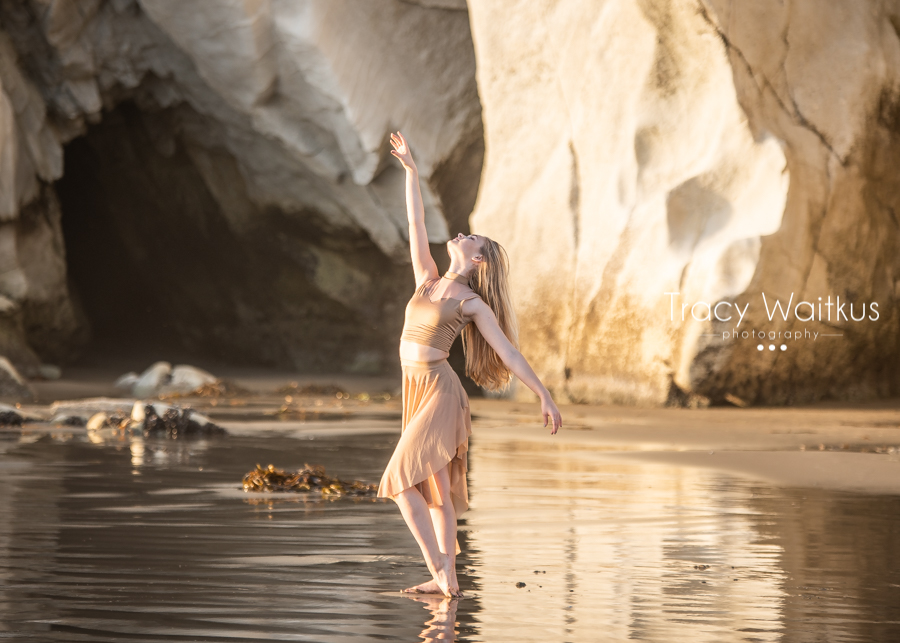
@gracephillips.dance captured at Pismo Beach, California with a Nikon D750 and Sigma 70-200mm 2.8 lens. Low tide conditions were key to getting this shot.
Styling
Once our location is set, I coordinate with my dancer(s) on wardrobe, hair, and makeup. Having all these elements work together helps create a cohesive mood and style in the final images. I think about the predominant color tones at our location and work with the dancer(s) to select costumes in styles and colors that will work well there. Ideally, I like to shoot each dancer in 2-3 costumes so we have a variety of final images. My dancers will either bring a selection of costumes to their shoot, or we will text photos back and forth ahead of time and decide which costumes to use and in what order.
Dancers are typically required to wear their hair in a bun during class and rehearsal, so they often LOVE the opportunity to show a little more individuality by wearing their hair down for outdoor sessions. Most of the dancers I shoot are high school age, and I recommend makeup that accentuates their features but is less heavy than stage/performance makeup.
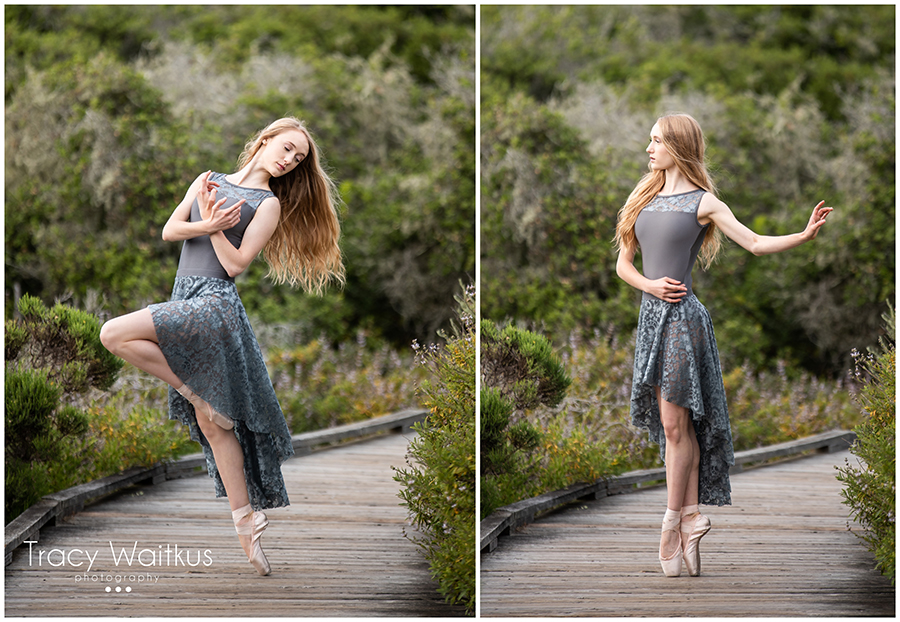
@kassandra.rose.dance photographed on a coastal boardwalk with a Nikon D750 and Sigma 70-200mm 2.8 lens. For me, Kassandra’s loose, wavy hair is a HUGE part of these images. And I love the combination of her dark grey costume with the green foliage.

@gracephillips.dance captured at the Leaning Pine Arboretum on the Cal Poly campus with a Nikon D750 and Nikon 85mm 1.8 lens. I love the femininity of Grace’s classical tutu and bun contrasted with the industrial greenhouse building. Leotard by @auditiondancewear.
Gear and Settings
I shoot with a Nikon D750 and keep a second camera (Nikon D610) in my bag as a backup. Capturing motion requires a fast shutter, so fast lenses are an important part of my kit, especially since I do not use strobes or flash outdoors. When space allows, I love shooting with my Sigma 70-200 f2.8 lens, especially zoomed all the way to 200mm, which creates great bokeh and background compression. For slightly tighter spaces, I’ll choose my 85mm prime lens. And for really tight spots, I’ll use my 24-70mm.
I tend to keep my aperture wide (between f2 and f3.2) not only to compensate for the fast shutter and get enough light, but also to maximize bokeh and put the emphasis on the dancer instead of the background. When shooting leaps or any type of motion, I choose a shutter speed of 1/400th or faster (if there’s enough light) and use continuous auto focus. For still poses, I can shoot slightly slower, but I still stay at 1/320th or faster, and I use single auto focus mode.
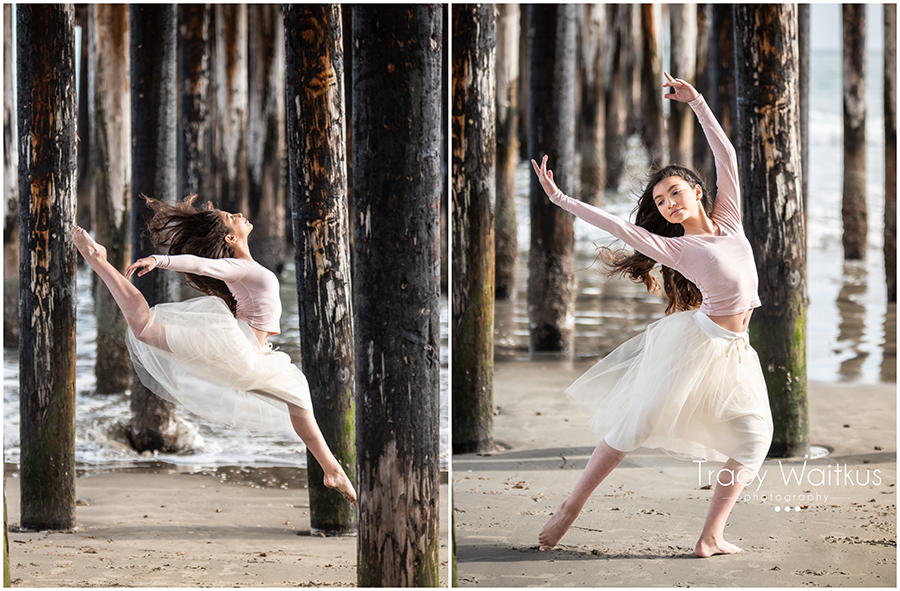
@mykayla_jayden_dance photographed under a pier with a Nikon D750 and Sigma 70-200mm 2.8 lens. I used a shutter speed of 1/500th to capture the motion.
Posing
Posing for ballet-inspired portraits is truly a collaboration between dancer and photographer. Not having a dance background myself, it has taken time and effort to learn about proper ballet technique so I know what to look for when my dancers are posing. I encourage dancers to prepare some poses ahead of time, focusing on their own personal strengths and choosing poses that flatter their lines and abilities. I also bring images on my phone which we can look at together and use as inspiration.
A few things to keep in mind:
- Safety is paramount. Never ask a dancer to attempt something risky. Be aware of the surface and environment, especially when the dancer is wearing pointe shoes. Check in with your dancer(s) throughout your shoot to make sure they are comfortable with what you are asking them to do. Be aware of any injuries or other issues that could impact their ability to hit a particular pose.
- I find that simple, sustainable poses work best. If a pose is too challenging or complicated, the dancer’s face can look strained. Dance poses should appear effortless, even if they are not!
- Look at the pose from several angles to choose the best vantage point for shooting.
- It may require several “takes” to capture a pose at just the right moment, particularly for leaps or other motion shots. Be mindful of the dancer’s stamina when repeating a leap or motion shot and make sure to give them breaks so they don’t become overexerted.
- Shoot “wide” so that you have plenty of space between the dancer’s body and the edges of the image. Don’t clip hands or feet when shooting full body poses.
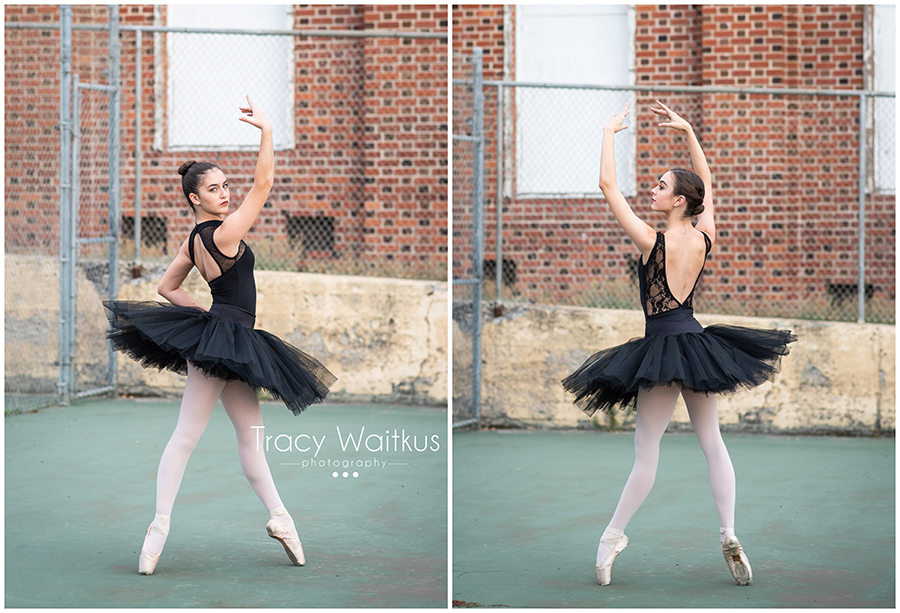
For my shoot with 16 dancers from @coastalchamberyouthballet, I let each dancer select their own pose for their individual shots. Sometimes having the dancer look off-camera works best.
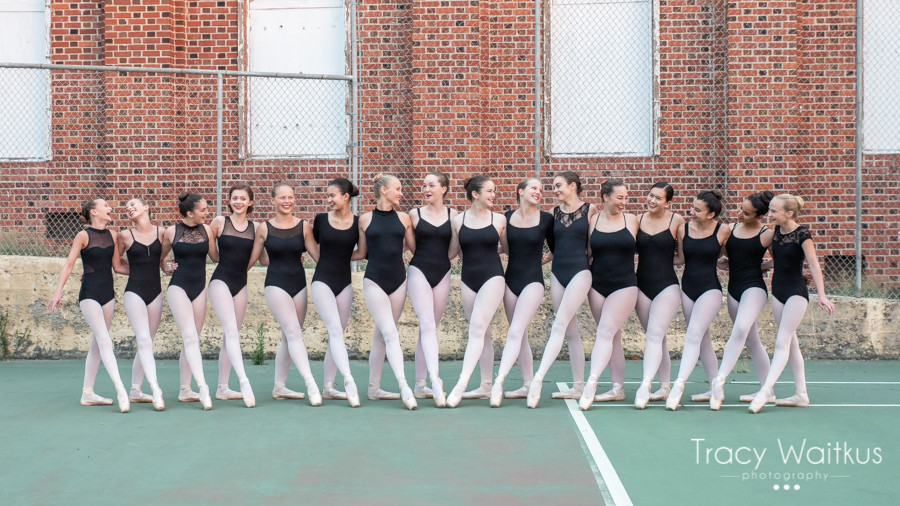
This fun and relaxed group pose of @coastalchamberyouthballet shows the camaraderie and bonds of friendship that dancers in a company develop.
Choosing and Processing Final Images
After shooting and uploading my images I search for the “keepers.” My keeper rate for dance shoots tends to be lower than for traditional portrait sessions since I am looking for shots with perfect technique as well as all the other elements that create a good image (sharp focus, interesting composition, good expression, etc.). If I have several images that are similar and I’m not 100% certain which is best from a ballet technique perspective, I may check with the dancer to see which image she prefers. A slight variation in foot or hand placement can make or break a dance image.
I tend to keep my post-processing natural. I really want the dancer to be the focus of the image. My editing checklist includes cropping and leveling, adjusting exposure and white balance if needed, sharpening and adding contrast and clarity, correcting skin tones if needed, and cloning out distracting objects if any are present.
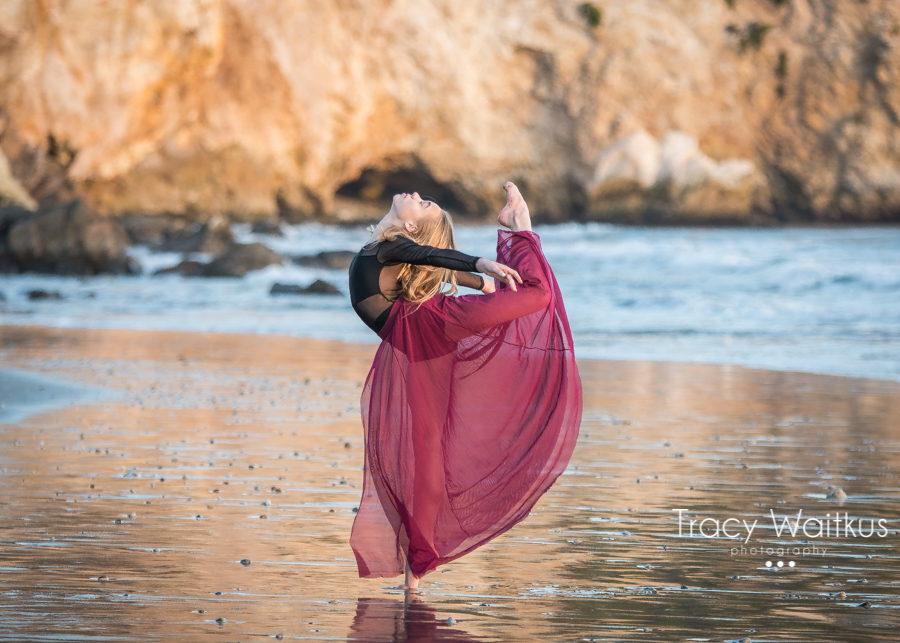
@haley_ballerina has amazing flexibility! I took several shots with this pose in both vertical and horizontal orientation, but ultimately liked this one best because she got her left leg up so high yet her face remained so serene.
How Did I Get Started?
Like many dance photographers, I got started by photographing my daughter when she became involved with ballet. As my skills and images improved, I offered to photograph her ballet company (for free at first) and ultimately negotiated a relationship with her studio and their non-profit performing arts foundation to be their sole photographer.
How do I find dance clients? I’m active on social media and follow and interact with dancers in my local area. I invite them to my group dance shoots, which are similar to mini sessions. I plan creative shoots with advanced dancers throughout the year, offering them social media images in exchange for working with me. And I do get a nice amount of follow-up business through my relationship with the performing arts foundation and dance studio I shoot for.
It has been a fun journey to shoot with so many talented and amazing young dancers. I feel very fortunate!

About Me
I’m a portrait and performing arts photographer in business for 6 years on the beautiful central coast of California. I’m also the resident photographer for Coastal Chamber Youth Ballet and Coastal Dance and Music Academy. You can find me here:
www.TracyWaitkusPhotography.com
Find me on Facebook and Instagram.

